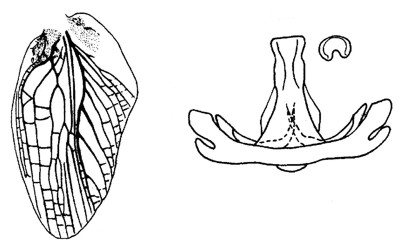Pests
Gryllotalpa stepposa Zhant. - Steppe Mole Cricket
Systematic position.
Class Insecta, order Orthoptera, suborder Ensifera, superfamily Grylloidea, family Gryllotalpidae, genus Gryllotalpa.Biological group.
Polyphagous pest.Morphology and biology.
Body length is 40-54 mm. Head, pronotum (except sides), tergites of abdomen, dorsal surface of hindfemurs, and part of tibiae are brown; the rest integuments are brown-yellow. Pronotum is elongate-ovate, 1.3-1.4 times longer than its maximal width. Forewings are 1.6-1.7 times longer than its maximal width, having thin, weakly pigmented transverse veins. Wings are projecting behind the end of abdomen, but the wings of brachypterous form reach only 4-5th abdominal tergites. Forelegs of digging type are short, enlarged, with strong dents. Upper inner part of hind tibiae has 4-5 spines. Epiphallus is comparatively long, having well developed prominent lateral lobes; its tip is almost semicircular in section. Parameres usually do not reach the midlength of epiphallus. Variability is displayed in features of forewing venation and wing length. Brachypterous forms are discovered in collections from the Crimea, Berdyansk, Krasnodar Territory, and Lenkoran. Male genitals vary slightly. The Mole Cricket digs a central vertical gallery 120 cm deep that finishes in a horizontal site for overwintering adults; larvae winter in vertical gallery at depth 70-80 cm. In spring a female makes a nest 6x6 cm in size at the depth of 10-20 cm and lays 300 to 500 tawny eggs by groups. Each egg is about 4-5 mm in diameter. In 2 weeks, mobile gray larvae hatch, leaving the nest after first molt. Larva length varies from 5-6 to 20-30 mm in six instars. The complete cycle of development lasts 1 to 3 years depending upon climatic conditions.Distribution.
Area includes southern territory of the former USSR, including Moldova, South Ukraine, Cis-Caucasia, Caucasus and South Turkmenistan.Ecology.
G. stepposa inhabits humid soil of freshwater pond shores and irrigated area, but it has high resistance to moisture deficit. Imagoes fly during evenings and nights, and they can float well. In warm time the insects burrow holes at the ground surface, while in winter the hole depth reaches 50-100 cm. Mass emergence after wintering is usually observed at temperature of 12-15°C. The Mole Cricket mates underground, then the female builds a nest. Egg batch consists of 100-350 or more eggs. Embryonic development lasts 10-20 days. Normal egg development requires 100% humidity. Hatching larvae remain in their nest, guarded by the female for 2-3 weeks. Feeding and burrowing holes underground, the Mole Cricket gnaws through the roots of plants, eating tubers and rhizomes. It also feeds on many soil invertebrates, including insects and earthworms. Natural enemies are birds (rooks, starlings, etc.), insectivorous mammals (shrews, moles), ants (destroying eggs), carabids (feeding on larvae), nematodes of the family Mermithidae, mites of the family Erythracidae. During winters with thaws fungal diseases may cause mass death of the pest.Economic significance.
The Mole Cricket is a wide polyphage. It damages cereals, legumes, perennial grasses, potato, almost all vegetables and melons and gourds, beet, sunflower, tobacco, hemp, flax, strawberry; it causes damage in hotbeds; in nurseries and young gardens it damages vines, fruit trees, and many other tree species. Shoots and young plants often perish after damage. Control measures include deep autumn plowing and inter-row treatments of soil, trapping in winter, and application of chemicals, poison baits, soil fumigation.Reference citations.
Fedorova M.V., Zhantiev R.D., Gokhman V.E. 1991. Karyotypes of the Mole Crickets (Orthoptera, Gryllotalpidae) of the European part of the USSR and the Caucasus. Zoologicheskii zhurnal 70(7): 43-50 (in Russian).Zhantiev R.D. 1991. Mole Crickets (Orthoptera, Gryllotalpidae) from the European part of the USSR and Caucasus. Zoologicheskii zhurnal 70(6): 69-76 (in Russian).
Zhantiev R.D., Korsunovskaya O.S., Sorokin N.N., Chukanov V.S. 2003. Sound signals in Mole Crickets from Eastern Europe. Zoologicheskii zhurnal 82(11): 1339-1346 (in Russian).


